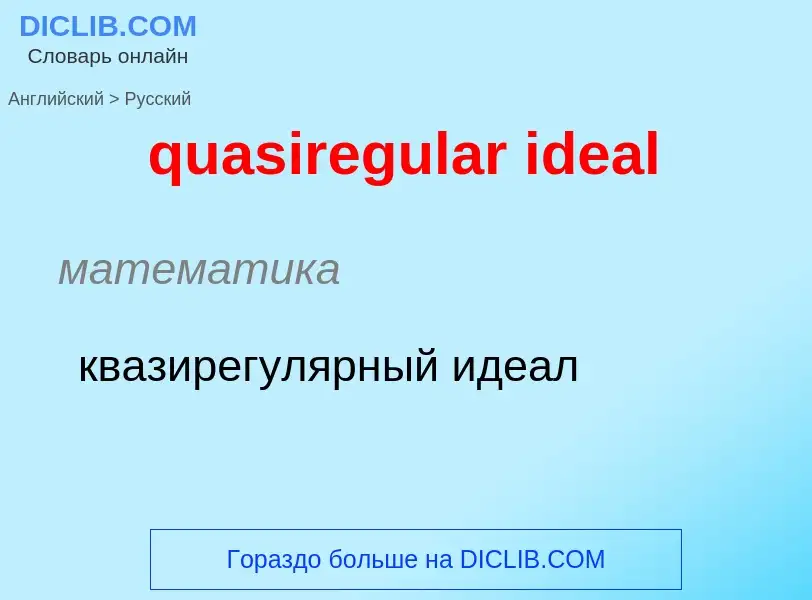Traduction et analyse des mots par intelligence artificielle
Sur cette page, vous pouvez obtenir une analyse détaillée d'un mot ou d'une phrase, réalisée à l'aide de la meilleure technologie d'intelligence artificielle à ce jour:
- comment le mot est utilisé
- fréquence d'utilisation
- il est utilisé plus souvent dans le discours oral ou écrit
- options de traduction de mots
- exemples d'utilisation (plusieurs phrases avec traduction)
- étymologie
quasiregular ideal - traduction vers russe
математика
квазирегулярный идеал
[ai'diəl]
общая лексика
абсолютный
дивизор
идеал
идеальный
мысленный
нереальный
несобственный
теоретический
прилагательное
общая лексика
идеальный
отличный
совершенный
превосходный
воображаемый
абстрактный
мысленный
нереальный
неосуществимый
идеальный, совершенный
воображаемый, мысленный
философия
идеалистический
синоним
существительное
[ai'diəl]
общая лексика
идеал
верх совершенства
образец
философия
идеальное
совершенное
синоним
математика
максимальный фильтр
ультрафильтр
Définition
Wikipédia
In geometry, a quasiregular polyhedron is a uniform polyhedron that has exactly two kinds of regular faces, which alternate around each vertex. They are vertex-transitive and edge-transitive, hence a step closer to regular polyhedra than the semiregular, which are merely vertex-transitive.
Their dual figures are face-transitive and edge-transitive; they have exactly two kinds of regular vertex figures, which alternate around each face. They are sometimes also considered quasiregular.
There are only two convex quasiregular polyhedra: the cuboctahedron and the icosidodecahedron. Their names, given by Kepler, come from recognizing that their faces are all the faces (turned differently) of the dual-pair cube and octahedron, in the first case, and of the dual-pair icosahedron and dodecahedron, in the second case.
These forms representing a pair of a regular figure and its dual can be given a vertical Schläfli symbol or r{p,q}, to represent that their faces are all the faces (turned differently) of both the regular {p,q} and the dual regular {q,p}. A quasiregular polyhedron with this symbol will have a vertex configuration p.q.p.q (or (p.q)2).
More generally, a quasiregular figure can have a vertex configuration (p.q)r, representing r (2 or more) sequences of the faces around the vertex.
Tilings of the plane can also be quasiregular, specifically the trihexagonal tiling, with vertex configuration (3.6)2. Other quasiregular tilings exist on the hyperbolic plane, like the triheptagonal tiling, (3.7)2. Or more generally: (p.q)2, with 1/p + 1/q < 1/2.
Regular polyhedra and tilings with an even number of faces at each vertex can also be considered quasiregular by differentiating between faces of the same order, by representing them differently, like coloring them alternately (without defining any surface orientation). A regular figure with Schläfli symbol {p,q} can be considered quasiregular, with vertex configuration (p.p)q/2, if q is even.
Examples:
The regular octahedron, with Schläfli symbol {3,4} and 4 being even, can be considered quasiregular as a tetratetrahedron (2 sets of 4 triangles of the tetrahedron), with vertex configuration (3.3)4/2 = (3a.3b)2, alternating two colors of triangular faces.
The square tiling, with vertex configuration 44 and 4 being even, can be considered quasiregular, with vertex configuration (4.4)4/2 = (4a.4b)2, colored as a checkerboard.
The triangular tiling, with vertex configuration 36 and 6 being even, can be considered quasiregular, with vertex configuration (3.3)6/2 = (3a.3b)3, alternating two colors of triangular faces.


















































































![Quasiregular polyhedra are generated from all 3 corners of the fundamental domain for [[Schwarz triangle]]s that have no right angles:<br>'''q | 2 p''', '''p | 2 q''', '''2 | p q''' Quasiregular polyhedra are generated from all 3 corners of the fundamental domain for [[Schwarz triangle]]s that have no right angles:<br>'''q | 2 p''', '''p | 2 q''', '''2 | p q'''](https://commons.wikimedia.org/wiki/Special:FilePath/Wythoff construction-pqr.png?width=200)
